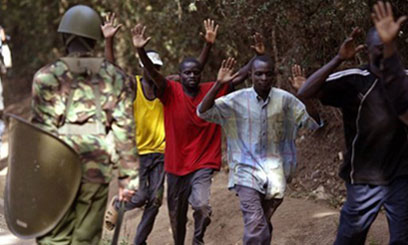 NAIROBI, Kenya Sep 26 – A District Commissioner who served in Naivasha during the 2007-2008 period when Cabinet Secretary Francis Muthaura is accused of having ordered the police to stand aside and watch as Mungiki massacred people took to the witness box on Monday, and dismissed the allegations as rumours.
NAIROBI, Kenya Sep 26 – A District Commissioner who served in Naivasha during the 2007-2008 period when Cabinet Secretary Francis Muthaura is accused of having ordered the police to stand aside and watch as Mungiki massacred people took to the witness box on Monday, and dismissed the allegations as rumours.
Lucas Katee Mwanza, who is now serving as the DC in Kilifi told the ICC judges that he did not see any Mungiki in Naivasha and “I could even have arrested them if I saw them.”
ICC Prosecutor Luis Moreno Ocampo has accused the Head of the Civil Service of having invited and hosted a gang of Mungiki’s at State House in Nairobi from where armed them with guns and machetes before deploying them to Naivasha kill people, in one of his spirited attempts to keep President Mwai Kibaki in power after the 2007 general elections.
Led in his defence by one of Muthaura’s lawyers Essa Faal, Mwanza testified that he did not see strangers wearing AP uniforms in Naivasha at the time of the violence, other than real APs and other security agencies who were part of a team he deployed to quell chaos.
Q: Did you see people wearing AP uniforms in Naivasha at the time.
A: I did not see them, in fact I could have arrested them if I saw them.
Q: Did you see strange people carrying guns
A: No I didn’t see them at all.
Q: Did you see the members of the Mungiki in Naivasha attacking people?
A: No Mungiki do not have labels, you wouldn’t know who is a Mungiki.
Q: Were members of the Mungiki ferried to attack people in Naivasha?
A: I don’t think any Mungiki were ferried. We could have easily known because we had intelligence. We could have arrested them.
Mwanza’s testimony before the ICC judges was immediately put to test when the prosecution provided evidence showing that the then Naivasha police chief Willy Lugusa had actually testified to the Commission Investigating the Post Election Violence (CIPEV) that he had intelligence reports that there were impending attacks in Naivasha.
Mwanza had told the court that the district security intelligence committee which he chaired at the time did not receive any prior information of looming violence. He told the court that the violence in Naivasha was spontaneous.
In his testimony, Mwanza also told the court that he did not receive any orders from any authority to stand aside and watch as strangers who were members of the Mungiki meted violence on the people.
“I didn’t receive orders from anybody. And from the best of my knowledge none of my officers received such orders and in any case, for us to stand aside so that Kenyans can kill each other, not at all. This cannot happen,” the DC testified and told the court how he and other top security chiefs in the region responded to quell the violence, often ordering police to use tear gas and clubs to disperse mobs.
“On 28 [of December 2007] there was a lot of tension in Naivasha but much of the violence took place on 27th. We said we have to use teargas, clubs and police swung into action because the mobs were throwing stones at the police,” the DC said of the more than 5,000 people demonstrating in the town.
He said communities mainly the Kikuyus, Luos and Luhyas were charging at one another and they had to disperse them.
“After sometime I also returned to Naivasha town and houses had already burnt in the highway with some people there. We arrested several people at least I was informed some were identified and we arrested 150 or thereabout and they were put in the cells,” Mwanza said as he recalled how the violence broke out in the town.
He said some of the demonstrators were complaining that they had been robbed by prison officers while others had been beaten “and they were saying all sort of things.”
“We had to swing into action. We told the police officers to clear the people out of the streets and people must go back to their houses,” he said of the action security forces took at the time of the violence.
He acknowledged responsibility in the management and deployment of Administration Police officers in his district and informed the court that the area police chief was solely in charge of the regular police.









































